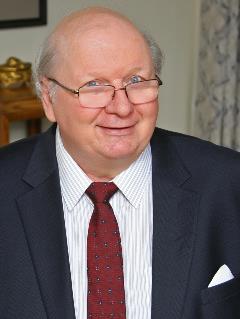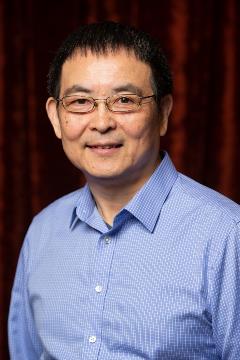Findings Staff Report | March 4, 2021
Imagine living on Mars. The air is mostly carbon dioxide with no breathable oxygen. There’s zero liquid surface water and no protection from the Sun’s radiation. It’s freezing—but the extremely low atmospheric pressure would boil your blood. Hurricane-force dust storms batter the landscape.
Yet, a small colony of people will live there in coming decades, says Professor Charles Doarn, inaugural director of the University of Cincinnati Space Research Institute for Discovery and Exploration, one facet of Research2030, UC’s new 10-year strategic plan for research.
Within 50 years, Doarn expects hundreds of people to live on Mars—a whole society. And that will present a whole lot of challenges.
“We’re just in the exploration stage now,” Doarn says, days after NASA successfully landed Perseverance Rover, part of the most advanced robotic mission to Mars to date. “Eventually people will bring their spouses and their children. We’ll need schools and infrastructure, law enforcement, courts and jails. Humans will need to live and work safely.”
That’s just Mars. There’s a whole universe out there, with countless challenges for the new space institute to address, UC Vice President for Research Patrick Limbach says.
“As we move into new areas of exploration—including robotic and human-tended missions beyond Earth’s orbit and the rapidly growing commercial space industry—UC will harness the knowledge and competencies of our faculty, students and partners to continue Ohio's extensive legacy of contributions to aviation and spaceflight,” Limbach says.
Doarn is perfect to lead this effort, university leaders say, because he has spent his career at the intersection of medicine, public health, engineering and program management. When he first arrived at UC in 2003, Doarn served as executive director of UC’s Center for Surgical Innovation. There, he helped oversee the development and construction of a physical teaching laboratory on the R level of the Medical Science Building. The center, inaugurated in 2006, remains a valuable teaching venue the Department of Surgery.
Today, Doarn is a research professor and program director of UC’s Master in Public Health Program in the Department of Environmental and Public Health Sciences in the College of Medicine. He has worked and partnered with many aerospace institutions, including managing a NASA Commercial Space Center, first at Yale University and then after it moved to Virginia Commonwealth University in Richmond, Virginia. He’s worked closely with NASA on preparedness and wrote its telemedicine plan.
The institute also has the guidance of two endowed chairs—experts in areas massively important to space research.
 First is Thomas Jefferson Chair of Space Exploration Tomasz Stepinski, head of UC’s Space Informatics Lab.
First is Thomas Jefferson Chair of Space Exploration Tomasz Stepinski, head of UC’s Space Informatics Lab.
Stepinski has a doctorate in applied mathematics and worked as a staff scientist for 20 years at the NASA-funded Lunar and Planetary Institute in Houston, Texas. He joined the UC faculty in 2010 and his research team at UC's Space Informatics Lab develops intelligent algorithms and online tools for fast and intuitive exploration of large spatial datasets originating from remotely sensed planetary data, including data from planet Earth.
“I develop tools which make intelligent exploration of these vast datasets possible, intuitive and accessible to the entire scientific community and the public,” Stepinski says.
The second expert researcher is Alan B. Shepard Endowed Chair for Exploration Ou Ma, who is developing technologies to make autonomous robots smarter and better capable of working together as a team or with human partners. Ma’s training and extensive experience includes collaboration on the design of the Canada Arm, first on the US Space Shuttle and now on the International Space Station.
Robots working cooperatively in a team is particularly advantageous and resilient in harsh conditions, like those on Mars, or other space missions.
 “Ohio is ranked second in the nation regarding the aerospace industry,” says Ma, who has a doctorate in mechanical engineering and robotics and joined UC in 2017. “Staying at the leading position obviously requires technological innovation and best trained workforce.”
“Ohio is ranked second in the nation regarding the aerospace industry,” says Ma, who has a doctorate in mechanical engineering and robotics and joined UC in 2017. “Staying at the leading position obviously requires technological innovation and best trained workforce.”
The institute will pull researchers together from all corners of campus to rise to space-related challenges, Doarn says, and the institute will have its headquarters at the new Digital Futures building when it opens in 2022.
The institute is already having an impact by organizing an all-day event called “The Future of Aeronautics: Connecting UC, NASA and Industry in Ohio” planned March 19 from 10 a.m. to 3:30 p.m. The virtual meeting with NASA Glenn Research Center will explore collaborations and opportunities in support of NASA’s goals. Interested parties can register here.
Doarn is also working to establish a set of multidisciplinary scholarships that could be available as soon as next fall.
Creating a successful institute means embracing an interdisciplinary and more inclusive approach to research, Doarn says.
“The future will not be the old guard making decisions. It will be lots of different people,” Doarn says. “Each new graduate of our engineering and applied sciences programs, as well as other disciplines within our vibrant urban campus, will be better prepared as a result of their involvement with our faculty, collaborators and this institute.”
More related news:
UC launches Space Research Institute
Mars rover mission has UC connections